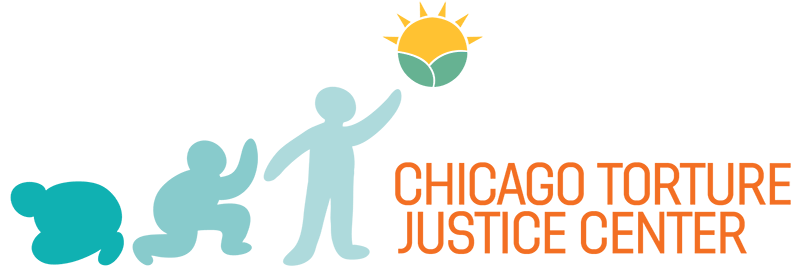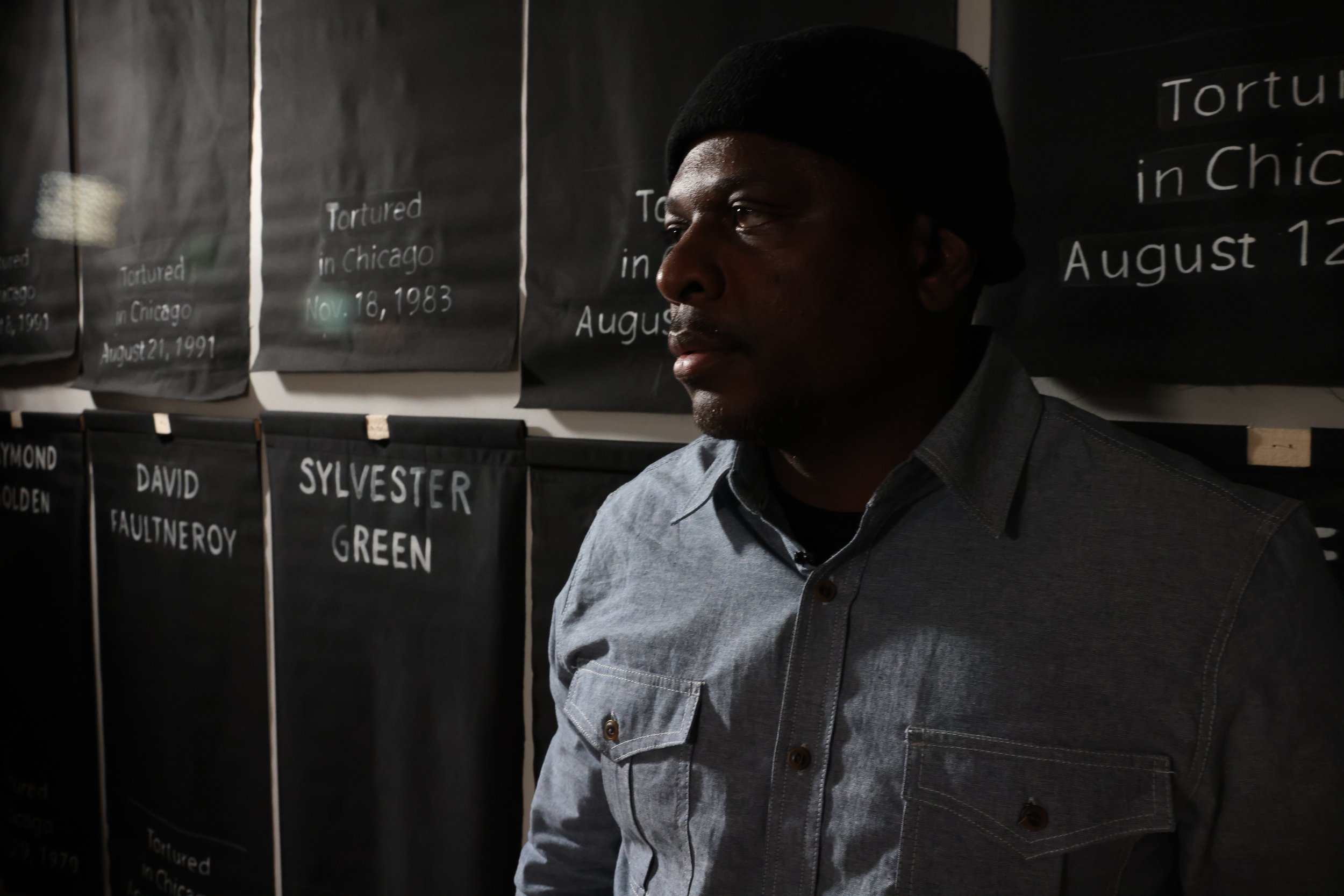Let’s have a more expansive conversation about the connection between state and intracommunal violence
Written collaboratively by the Chicago Torture Justice Center team and published in The Triibe on February 16, 2023. Our team put together this article over the course of many months, coming together through a number of discussions and sharings about the collective lived experiences by those in our community.
Introduction
A photo of Carl Williams, CTJC Learning Fellow, in front of torture memorial banners. Taken by Jean Melesaine.
The Chicago Torture Justice Center (CTJC) is comprised of individuals who have survived unconscionable conditions. In both explicit and implicit metrics of violence, we have survived brutal assault at the hands of police, lengthy incarceration, sexual assault and intracommunal violence. We decided to take on the creation of this project collectively as a writing team. While we want to offer this piece within a context of existing research and statistical realities, we know academic knowledge does not outweigh the value of lived experience, so we are guided by this understanding.
Sometimes described as “gun violence,” intracommunal violence — violence within our communities — is something we have intimate knowledge of, both from direct impact and in the ripple effects we’ve experienced as family and community members. We have been in conversations with our community over the last year expressing our desire for more of a politicized analysis of the connections between state violence and intracommunal violence. These two types of violence tend to be characterized as distinct, but we know from our lived experience and researched evidence that this distinction is arbitrarily given and inaccurately stated. We offer this piece as both a glimpse into our thinking and with a genuine curiosity of what might be possible with a more expansive and politicized articulation of the connection between state violence and intracommunal violence.
Chicago is frequently the center of national news highlighting the brutality and racism of its police department and criminal legal system (the John Burge tortures, Homan Square, being the wrongful conviction capital of the country, the Chicago Police Department (CPD) consent decree, to name a few of many). More often though, when Chicago is named, it is generally associated with discussions about high levels of community violence and shootings in specific parts of the city; such as Austin, North Lawndale and Englewood. Violence within the city is presented as distinct and unconnected from its contextual factors. Most of the attention and emphasis is placed on who is committing the violence and ignores the myriad of factors that lead up to and instigate it.
The trope “Black-on-Black violence” is a frequent, yet faulty simplification of what actually unfolds within our communities. This simplification serves to veil overt state violence and its relationship to intracommunal violence. This practice of active framing and omission creates a false binary that illogically supposes that, “if you take a stand against state violence then you don’t care about intracommunal violence,” and vice versa. This narrative does not acknowledge how closely intertwined and pervasive systemic state violence and intracommunal violence are. This omission serves to compound trauma and perpetuate violence that continues to deeply impact our communities.At CTJC, you will often hear us ask ourselves and our community the question, “Who does it serve?” We now present this question to you.
Who and what does it serve to talk about intracommunal and state violence separately?
To initiate this conversation we offer the following proposal: Centrally organized state and structural violence produces singular acts of harmful behavior along the margins; it is not the other way around. The resulting symbiosis between conditions and harm produces an ideology that devalues certain lives and limits what is possible within this context. This is true both in the external perception of the community, and in the lived experiences of the community members. By understanding this deeper context, the many and varied responses of impacted communities is both devastating and a logical progression.
Intracommunal Violence Is A Symptomatic Reflection Of State Violence.
It is well known that economic inequality is directly and causally linked to increased levels of intracommunal violence (Kennedy et al.,1998; Pickett & Wilkinson, 2015). The state bears the responsibility for creating the conditions that perpetuate intracommunal violence, while simultaneously actively ignoring these conditions. This exploits both the conditions and the resulting violence in order to maintain and endorse an unjust and violent system of policing and incarceration. The state has continuously fortified a system that punishes and disappears cherished members of our communities. Despite the expressed intentions of state violence to ‘serve and protect’ (again, who is being served and protected?), what we experience is a one-dimensional approach that repeatedly performatively fails our communities, despite there being no actual intention of resolving the conditions (no redistribution of wealth, no erasure of poverty, no targeted employment programs to communities who are forced into informal economies, etc). Despite these “failures,” the state continues to want and need us to believe that more policing and incarceration are the only tools available to address intracommunal violence.
Left to right: Gregory Banks (Safety Coordinator), Carl Williams (Learning Fellow), and Mark Clements (Organizer). Photo by Jean Melenaise.
The state itself often fails to both recognize and define mass and systemic inequality as violence. Our community is intimately acquainted with violence beyond the physical realm that includes unaffordable and unstable housing along with lack of access to fresh food and inadequate healthcare access. Our community lives with this outwardly subtle, yet inwardly pervasive violence every day. Systemic deprivation of life-sustaining resources is a form of violence, and intracommunal violence is a logical reaction to this state-created deficit. It is unreasonable and irresponsible to assume that when the state and its adjoining systems and institutions hold communities and the lives within them as dispensable and absent of value, there would be no short- or long-term impact.
Generations of communities experience this treatment through systems, policies and structures that exist to remind us every day of our perceived lesser place and worth in society. It is reasonable and expected that these problematic sentiments become internalized. This impacts how we treat one another and what we believe is achievable in our futures. Imagine in your personal community and family how actions and attitudes would change if you couldn’t envision a positive future for yourself or your family, find a stable place to live, or secure food and medical care. The devastation is very, very real and cannot be overstated. A psychological phrasing for this phenomenon is called foreshortened future. What happens to an entire community who experiences a negative assumption of what is possible for their future based on a seemingly accurate assessment of current conditions?
To Be Even More Direct, Intracommunal Violence Is Not Only A Symptom, But A Consequence Of State Violence.
States control the distribution of resources through their power to make decisions, laws and policies. Additionally, states shape and determine the function of communities. This is easily identifiable with individuals released from incarceration. They are not given full citizenship or equal protection under the law because they are prohibited from accessing a multitude of employment and housing opportunities. Even after repaying their “debt to society,” those who have been incarcerated are shoved into unending cycles of poverty and criminalization. We must ask — what is society’s debt to these individuals? Have they not been failed by the state and its systems? It is these state policies that create barriers to re-entry that may result in communal violence by forcing people into informal or street economies. Eliminating social mobility and increasing chronic unemployment does not provide safety; it corrupts it.
As individuals and community members, we have seen and participated in coping responses that are both active (resistance, education, advocacy and organizing) and avoidant (self-preservation, detachment, substance use and hypervigilance). Both responses are brilliant adaptations that allow for our survival. We recognize that sometimes the coping response instigates intracommunal violence and sometimes it doesn’t. When we view coping strategies in context of the conditions, harm and ideology we are swimming in, we recognize they are to be revered as incredible practices of survival rather than isolated pathologies.
“A relationship exists between the presence of state violence and intracommunal violence. These conditions are no accident...”
Conditions
The highest concentration of intracommunal violence occurs where disenfranchisement and deprivation are most concentrated. Historically where we see redlining, food apartheid, pollution, poisonous infrastructure, school closing, hospital closings, housing destruction, mental health divestment, gerrymandering, labor suppression and incarceration and torture, we also see the highest numbers of shootings, robberies and assaults. A relationship exists between the presence of state violence and intracommunal violence. These conditions are no accident and these connections are understated and hidden so that the only response that appears logical is to implement more policing and surveillance. We then experience more police presence, more arrests, and more incarceration, among other forms of state violence. When the focus of mainstream media and elected officials is solely on intracommunal violence and not the role of the state in its creation of these conditions we miss out on actual solutions that care for our people and address root causes.
Harm
A structural lens clearly reveals that systemic harms will be reproduced in communities between individuals. Our society assertively imagines violence and violent punishment as an effective response and deterrent for perceived deviant behavior. Such an approach is absent of healing, repair, and accountability and, in actuality, carceral systems paradoxically produce more human beings prone to using violence as an important survival or protective behavior.
The state-sponsored violence against incarcerated people induces harm within prisons, and the stigma of being incarcerated perpetuates this harm upon release. The regimentation and rules within prison walls — and the multitude of unending collateral consequences upon release — are designed to dehumanize individuals. In addition, there are the manied collateral consequences placed upon the incarcerated individuals’ loved ones while they are inside which include social isolation, shame, and added financial costs for phone calls, the commissary and transportation for visits.
A photo of La Tanya Jenifor-Sublett, Peer Reentry Program Director. Photo by Jean Melenaise.
The compounded impact of generational and chronic trauma narrows the emotional resources of communities, locking many people in cycles of fight/flight/freeze. Our traumatized bodies then make decisions within our communities from a space centered around a form of survival that is based on a constant assessment of danger. When home communities are unable to address the dangers within, the resulting response often manifests as an absence of hope for a different future. Individualizing dysfunction leaves us ignorant of the impact of social conditions. We are stuck in this cycle because the state repeatedly makes the decision to neglect vulnerable people and communities and invest in violence as opposed to developing healthy communal infrastructure. This neglect of vulnerable communities serves several purposes, including protecting (and more often enhancing) the property values and wealth of communities that receive greater state-sponsored resources, create narratives that obfuscate state neglect and abandonment and instead prioritize investment toward private big business, tax loopholes for corporations and massive investments in military and domestic policing.
Ideologies/Systems/Structures
State violence is not a passive cause/determinant of community violence. The state actively reproduces and compounds intracommunal violence through budgets that prioritize a false and purposely dangerous idea of ‘public safety’, and by implementing an uneven distribution of (or removal of) resources.
“Violence” can be defined as the intentional use or threat of harmful force or power. State violence, then, is centrally organized and distributed harm. When our city insists on resourcing state violence at levels that far outpace the levels at which it funds communities (through housing, employment, healthcare, mental health support, water and infrastructure, green space and access to nutritious food sources), we see with great clarity how elected officials make choices that deepen this disconnect. These decisions decimate community safety and continue to hold state violence in connection with intracommunal violence by turning away from grassroots demands (the Peace Book, Treatment Not Trauma) and toward increased policing—especially in areas that are already policed and under-resourced. Note: APHA position on Advancing Public Health Interventions to Address the Harms of the Carceral System.
Conclusion And Way Forward
In the current state of disarray, we are left without effective recourse because we have yet to recognize that the ‘solution’ of state violence is actually the problem. By naming these connections we turn the trauma and violence of policing and divestment in Black and brown communities into something actionable. When we rebuild our foundation of understanding then new solutions arise and future possibilities open up.
There are many public actors that perpetuate this violence while the community pays the price economically, socially, educationally and — unacceptably — with their lives. We acknowledge that some within our communities turn to intracommunal violence while the majority do not, despite sharing many factors. Some may be tempted to put the responsibility onto the community members engaging in this violence, but to put the responsibility on them without support structures in place would be to ignore the powerful inequities that perennially exist and created this structure in the first place.
“When we understand why intracommunal violence exists, solutions to address it become possible.”
We also acknowledge that within our communities there are victims of intracommunal violence (both personal and by proxy within their more intimate circles) that, as a result, ask for more state violence in the form of requesting a police presence and demanding ‘justice’ as defined by our criminal legal system. We believe this is a complex issue that deserves attention, and is a result of generations of internalizing these problematic public sentiments with discourse that erases the role of the state as the architect of the conditions. Our work is needed here, too.
There is a risk to the community demand of accountability by undermining and erasing the collective action our communities have already taken — and the work communities continue to lead. Not only is there something we can do about these systems and these connections, but communities have been doing this work all along. Historically we see the state push binary viewpoints and solutions which are tried-and-true relics of colonialism and white supremacy. We believe these nuanced complexities require the intimate knowledge and expertise of local organizations, communities and people already doing this work. A shift is required here as well, as all too often we see the state blame these organizations, communities and people in an effort to preserve a sense of false neutrality.
While we hope to have presented an initial overview of the issues related to intracommunal violence and the causal links between intracommunal violence and state violence, we acknowledge this is a minute first step on an epic path worn over four centuries. Our goal is to speak unapologetically to the state that these binaries have served, and to open a space for the solutions to emerge from the communities that are most impacted. We also hold immense collective grief over lives lost, families torn apart, and trauma inflicted onto our communities. We do not have all the answers; they are not easy to come by. However, we have not lost hope. Our goal is to initiate a public awareness of what we know to be true through our communal lived experiences and through the data that has come from investigating the relationship between communal violence and state violence.
When we understand why intracommunal violence exists, solutions to address it become possible. If intracommunal violence is a consequence of the systemic abandonment of poor Black and brown communities, while simultaneously massively funding resources to private businesses, corporations, detentions, surveillance and law enforcement, there is no mystery of why conditions exist the way that they do; instead the befuddlement performed by politicians becomes clearly duplicitous. Furthermore, the blame then that is often attributed to these very communities for their response becomes even more cruel.
The most pressing question we should be asking and moving from is, how do we change these conditions; what do people in our communities most impacted by intracommunal and state violence say that they/we need in order to thrive and flourish instead of being controlled and silenced? Other questions we are eager to engage in include: Who is willing and able to help us in this conversation? What are solutions that are long lasting, that get at the root issue of a society organized inequitably and the resulting disparately violent impact it produces?
We look forward to continuing the conversation.




